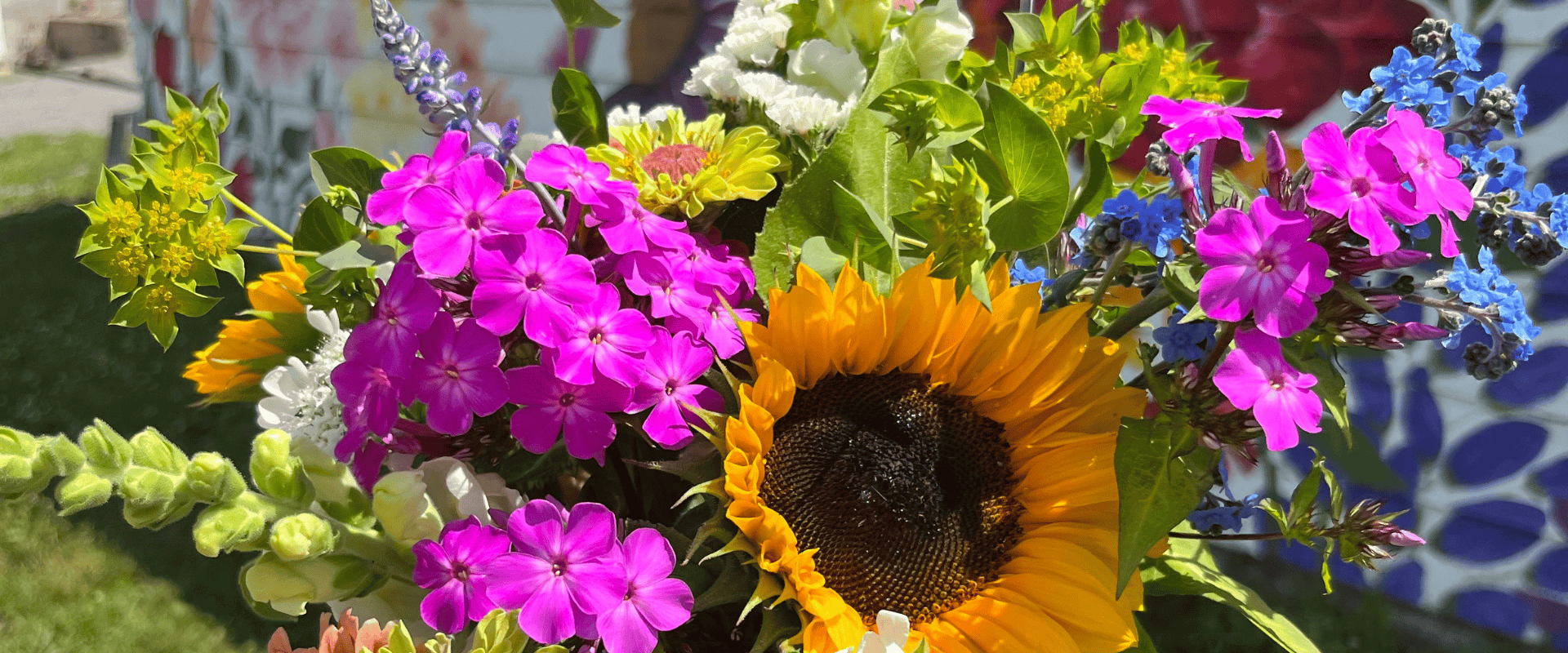
Welcome back to another episode of the Sunny Mary Meadow podcast/blog. Today, we are going to talk about making a bouquet. I think the very first thing we have to talk about is a bouquet vs. an arrangement. An arrangement is perfectly symmetrical, the stem lengths are all varying perfectly so that you can view every flower from every angle. It’s a lot more floral design than a bouquet, which is typically like a market bouquet of a bunch of flowers. With a bouquet, you buy the flowers, and then you bring them home, and you can arrange it yourself. Bouquets are definitely what I sell to my customers. I will somewhat arrange it in a mason jar for my subscription holders, but I’m definitely not taking the time to arrange it perfectly and put in all the design elements, mainly because of my price point. The reason I’m able to sell them for what I sell them for is because I don’t factor in a lot of time. If I had to take 20 minutes to make a bouquet, I would not be able to do that for the cost that I sell them for. My subscriptions this year are $25 per week (credit card fees are taken out of that, which reduces my net profit). I do add tax on my subscriptions on my website, but when I’m selling them at STEM bars and stuff, I don’t add tax. They’re $30, and then the tax is included.
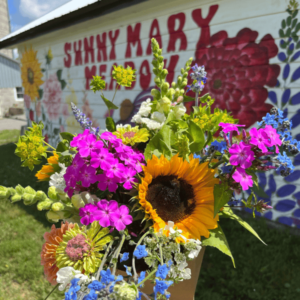
For subscriptions, I need to make sure they’re affordable for the customer so that they want them. If I said subscriptions are $45 a week, people just aren’t gonna buy them. They want the $25 a week, which means you know, they’re not perfectly arranged. I think they still look very nice, and they’re in a mason jar. Sometimes people end up bringing them home and rearranging them anyway, but in general, my bouquets are cheaper than an arrangement because I’m not taking a significant time to perfectly prepare them.
I also talked about this in the episode where I talked about my ebook, Every Room Blooms, through Unpacked Publishing. They partner with a lot of different people with social media accounts, such as mine – people who are experts in their field. There’s someone who lives in Alaska, and she wrote a book on insider trails to hike when you’re in Alaska. Someone else did one on how to do your makeup properly. I think her book was like $14. Someone else wrote one that was like $6, where she talks about how to take control of tidying up your house. It was literally an ebook to follow step-by-step on how to get your house in order. I have written three of them – the first one is Every Room Blooms and is about how to direct seed a cut flower garden for yourself. The second one is Backyard Blooms, which is about perennial flowers to put in your landscaping that also works well as cut flowers. Then the one I’m going to talk about today is Bouquets in Bloom, which talks about how to make a bouquet. Access my e-books here.
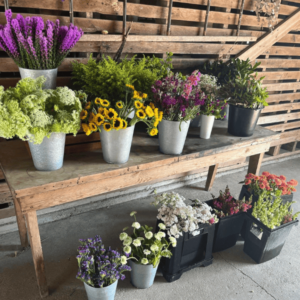
This is for someone that comes to one of my stem bars, where there’s 12 different kinds of flowers, and they want to make an arrangement. Or someone who buys buckets of flowers from me and needs instructions on how to build a bouquet using them. Say someone buys five five-gallon buckets of flowers, I charge depending on the kind of flowers they want and if they’re okay with a mix of colors versus if they want specific colors. If they want specific colors, I do charge a little more. Typically, buckets of flowers range from anywhere between $60 and $90, depending on the types of flowers. It can vary quite a bit. But say they’re $75 each, and they buy five buckets of flowers because they want a bouquet on every table for a wedding anniversary party. It’s a pretty good deal compared to wholesale or having me make 30 some arrangements – you can get about 30 arrangements out of five buckets (maybe even a little more than that because I usually get between five to seven per bucket). This book walks them through the steps of how to make their own bouquets and have them look nice.

The first thing you’re gonna want to do is gather your supplies. When I’m making these bouquets to sell, for example, if I’m going to a vendor fair or some sort of market when I have my bunches of flowers in craft paper, I like to make about five bouquets of each combination because that’s how many fit in a bucket. Even if I have them in mason jars, kind of all next to each other, I like to have ones that look the same rather than spreading them out because I think it just looks nicer. I try to focus on things like, those are purple and orange, these are a bunch of light pinks, and those are a lot more whites and greens rather than mixing them all together on the table. For my subscription holders, if I make 50 bouquets and I have three different kinds to choose from, I will still divide them up a third, a third, rather than mix them all together, even though that might look nicer. I do this because it gets busy looking when they’re all mixed, and people can’t tell what they want. I also think they make a greater impact when they’re bunched together with the ones that look like them.
The first few years that I had cut flowers that I sold, I kind of had to make them with what I had. I talked about this earlier, but I would grow a ton of mixes. I planted like a mixed seed pack of zinnias, snapdragons, or whatever it may be because those seed packets are cheaper. So that’s what I bought. Well, now I will buy a packet of the same color so that an entire row that’s 60 feet long with 700 plants in it can be grouped. For example, maybe the first half of the row is purple Benary’s Giant zinnias, and the second half is lime Benary’s Giant zinnias, rather than a whole mix of different colors of zinnias. Because when I make the bouquets, then I can really stick to certain colors, and now it’s a lot more fun to cut as I go.
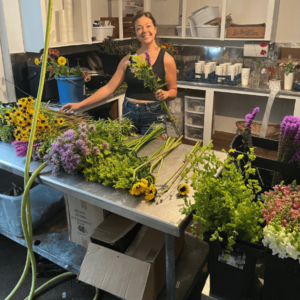
So, I tried to come up with a different recipe for my subscriptions every week. There are 50 subscriptions on Wednesdays in the summertime, so I need to make 50 bouquets. I typically have two or three different recipes for those just because of the number of flowers I need, and I’ll figure out which colors I want and see how it goes. Sometimes for fun, rather than setting them all out at once, I will set out half of them since there are two different color combinations. That way, I can make sure that people who come later in the day have the same opportunity to get their choice of colors. Otherwise, one of the color options is all snagged up first. It’s funny, though, because, for the most part, it really evens out. Sometimes with the tulips, just to see what will happen, I will put some in mason jars and some in floral sleeves and see what people take. Typically, it ends up being half and half. It’s like, “Oh, okay, well, that worked out pretty well.”
After I pick the flowers, I let them sit for at least an hour or even overnight (which is best), before building the bouquets. I try to harvest in the evening or immediately in the morning. I’ll use the ones harvested in the morning to make bouquets in the evening for pick up the next morning. And I’ll use the ones harvested in the evening for bouquets for pickup later the next day. The flowers need to hydrate and soak up water before you start working with them. When I pick them, I also do my best to leave the leaves in the garden. So, I will take the flower and remove any leaves from the bottom six inches of the stem. I just take my fingers and run it down the stem and get rid of any excess leaves or foliage because I don’t want anything besides the stem in the water, or it just is going to harbor bacteria, and it really shortens the vase life. It’s best to do that in the garden when you’re harvesting (do this into a bucket, though – don’t leave these leaves on the ground). And don’t pick in the hottest part of the day. Again, earlier in the morning or later in the evening is best. Right away in the morning, it’s still pretty dewy, so if you can wait until that’s started to dry up, that’s best. But if I had to choose, I’d rather have a little bit of dew and not as much heat.
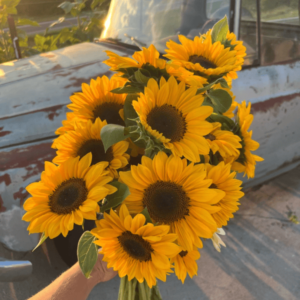
There are many types of foliage and fillers that you can use in your bouquet that are likely growing right in your landscaping. I’m not trying to get you to steal from your landlord if you rent an apartment, but a couple of stems probably won’t be noticed. Kidding … don’t do that. That’s wrong. Don’t do that. Again, my book Backyard Blooms describes flowers that you can plant in your landscaping that works really well for cut flowers. Even if you buy a bouquet of something at your local grocery store, and then you just want to fill it out and make it a little bit nicer, you can even put some hosta leaves, or some spirea plants, or even peony leaves, in to fill out your bouquet. Peonies bloom in June, but in July, the bushes are still there, and you can cut stems of leaves off to add in there.
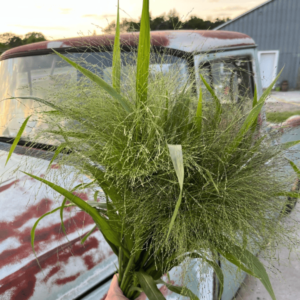
When it comes to color schemes, that’s something I truly believe is ever-changing with trends, and beauty is in the eye of the beholder. The last year I was asked to do so many bouquets of just greenery and foliage, and I just had to laugh because I’m like, “Well, where’s the flowers? You just want greens? Okay, you just want the greens. Okay.” I just got asked to do a wedding, and she said that she wants all white flowers on the table and pink flowers on the head table. I cautioned her that by the time the guests get there, and they’re wearing clothes that don’t follow the theme, I just don’t think it’s going to be the impact that she wants. Right now, the trend is a lot of neutrals and whites mixed with a little bit of color. Like I said, that’s fine, it doesn’t matter what I like, it matters what the customer likes and whatever the trends are, and I try to stay up to date as best as I can.
My biggest piece of advice is to use the colors that you like. I understand that not all colors work well together, but for the most, you can make things work. Reds are really hard, and I hardly grow any straight reds – I’ll do some dark maroon or deep burgundy, but just straight reds are really hard to mix in. There’s really not a good time of year for them unless it’s literally Fourth of July week. And it’s not worth it to me to grow red zinnias because if they’re not blooming for that exact week, it’s not worth it. As I said, just try to use colors that you like. I’ve pretty much eliminated the jack-o-lantern orange and the bright reds. These colors are just sometimes difficult to work with. Salmons, pinks, pale yellows, purples, and greens – those are my jam. I tend to try to go with hues and shades more than the colors themselves. So, I like more moody mauve and pastels, and I’ll put some vibrant solid flowers in there, too. But again, my advice is to do what you like.
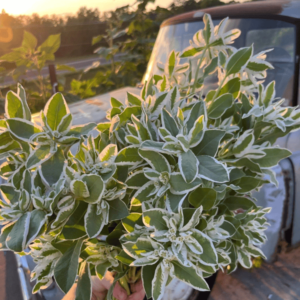
Once you have the colors picked out and harvested, the next thing you want to do is prepare your stem. Again, you will want to remove the leaves that will be below the waterline. When it comes to additives for the water, I just use fresh cold water in a vase. I don’t add anything. We can talk about harvest and vase life in another episode, but ultimately, I know some people would put a penny in there, some people will use an aspirin, some people will use floral prep, and some people will do a drop of bleach. What I say is just dump it out daily. Honestly, they kind of take a little work to keep them looking fresh. Ideally trim the stems every single day and trade out the water every single day. I know that’s a lot of work, but if you just do it and dump it out, they’re going to last so much longer.
When it comes to types of flowers to use, typically, the rule of three is that a bouquet should be a mix of focal, foliage, and fillers, and that will make them look great every single time. However, to make them look more whimsical, like my style, I like to make sure that I have a focal flower (something like a Benary’s Giant zinnia, or a sunflower, or a peony), a spike, a disc, a filler, and air. I didn’t invent these terms, but a gal named Erin started preaching about these elements, and honestly, it was a game changer in the way I make bouquets. I get so many compliments when I use these rules. And the rule of three, where it’s focal, foliage, and filler, I just kind of threw out the window. So, the rule of three is a principle of design that we like things in three. So, any design blog will say, plants and landscaping, pillows on couches, Christmas decorations, things like that … it’s very structured, and things should come in threes. Again, if you’re making an arrangement, I believe that that’s true, you should have three of this kind of flower, three of that kind of flower, and a third, and a third. And have them structured together so that they’re not spaced out. But again, with the bouquets I’m making that are market-style, wild, and whimsical bouquets, you don’t need them to be structured. We need texture. We need a little wilderness.
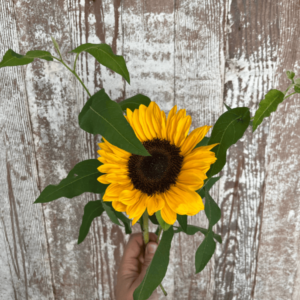
Now, I want to talk a little bit about focal flowers … sunflowers, lilies, peonies, dahlias, and then the large varieties of zinnias. I used to sell sunflowers in bunches of 6 for $12, but I quit doing that because I realized that I could take those same six sunflowers, mix them with some greenery, some zinnias, and some of my filler flowers in there, they’re just way less value-filled. Sunflowers are a “one-and-done” … they bloom, and then they are done, which makes them a more premium flower. So, I can make those premium flowers stretch a little bit farther by adding other types of flowers in there. Now I essentially sell each of those six sunflowers for $25 each because they’re mixed with other flowers. So, instead of, you know, $12 – $15 for just six sunflowers, now I sold them for more. Even if I did $15 for a bunch of just sunflowers, five bunches would bring in $75. Now, I can make $150 from them, literally just by adding some other flowers mixed in that are not my valuable, premium stems. Those premium stems I really like to try to divide out, and I don’t sell them in direct bunches anymore, even though it would be a lot less work to sell them that way, because you’re not taking the time to make the bouquets. Then again, I’m constantly learning. Maybe I’ll look back at this blog post and laugh, and maybe all I’ll do is sell straight sunflower bunches again in the future.
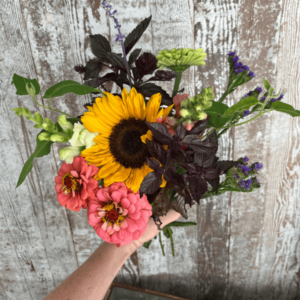
When I talk about spikes, I’m talking about snapdragons, salvia, amaranth, gladiolas, etc. They add height and make it all look really interesting. It’s an attention grabber because it’s sticking out of the bundle. Spikes are actually the one time that I go with the rule of three in my bouquets. I like having three in there because one just looks weird. Usually, I try to use three of the same types, but it depends on what I have blooming. Sometimes I’ll do one amaranth, one snapdragon, one salvia … or two amaranths and one snapdragon … or sometimes three snapdragons. It’s nice to have three different things for that height element.
The next flower that I make sure I add is a disc of some sort. So, a circular shape – cosmos, zinnias, marigolds, asters, etc. Whatever it is, it’s something in a circle. Not everything can be pointy and whimsical, you need some normalcy. They take up space, they stay put, they take up volume. My favorite variety of zinnias is Oklahoma salmon because they’re really small. The Benary’s Giant variety, which is like three inches around, is focal, but these Oklahoma salmon are smaller and are considered a disc. And once again, I like to add three of the discs, but it’s not a third of the bouquet, and they’re not all bunched together, but it just adds some good volume. And maybe you only need two, or maybe you need four just to kind of take up a little bit more volume. Kind of play it by ear.
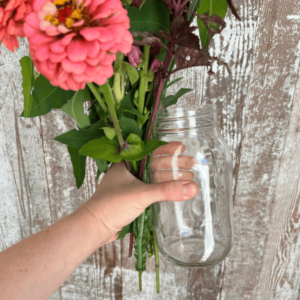
Filler ideas – essentially, this is “greenery,” but don’t get caught up in the fact that they need to be green. Sometimes they can be different colors of hosta leaves, or they can be amaranth, honeywort, Bells of Ireland, basil (my basil is usually purple). Nearly 50% of a bouquet can be made up of fillers to bulk it up, and that’s okay. You can have six stems of greenery in there if you want.
The “air” components are like ornamental grasses, scabiosa, cress, waxflower, or statice. They don’t really take up volume, and just adding one or two can go a long way. I try to keep them among the longest in the bouquets. It’s just something that kind of adds a little touch to the end. They don’t really take up space. It’s like adding dogwoods in a Christmas porch pot, where it’s just kind of sticking out like a little accent.
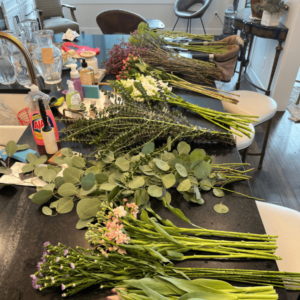
So, now you are ready to put it all together. I find that I can never get it quite right if I try to arrange it in a jar. And that’s probably because that makes it an arrangement. So oftentimes, if I do that, I end up with really short stems because I keep trying to make it look right. I’m like, “Oh, take a little bit off this one, a little bit off this one …” and then they end up being short. Over time, I’ve learned to just arrange them in my hand. So, I will stick out my left hand, grab the focal flower, and then add stems as I go. I turn the bouquet a quarter turn, viewing it from each side, and then just keep adding to it from around. So, think of it as a circle with five layers around it, or like an onion. You just start with your focal flower, and then you just add ingredients. Once I’ve got the focal, I add the biggest fillers that I have, kind of creating a barrier between those next plants and the focal flower so that you really see the focal flower and it doesn’t get mixed up with the discs. Then I’ll add the spikes because I don’t want those on the edges – I want them more within the arrangement. Then I’ll do my disc flowers. Then the rest of my fillers. Then I try to put the “air” somewhat on the side. So, it’s kind of just off on its own doing its own little thing. If using a sleeve, I want the top of the sleeve to meet the top of the flowers, it protects them, and then they still look really pretty because you can see them, but they don’t get bent up.
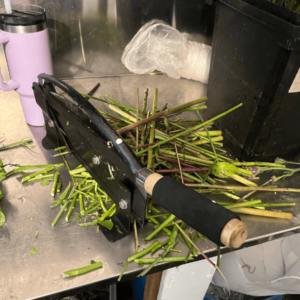
As I talked about in a recent post, this year, I bought a stem cutter and will likely be a second one. It’s kind of like a massive paper cutter. And it allows me to cut the stems for my 50 subscriptions a bouquet at a time, rather than cutting each individual stem with scissors. It really saves a lot of time.
Here are a couple of the recipes for bouquets I mentioned earlier – one recipe would be one sunflower, two snapdragons, one amaranth, three zinnias, three honeywort, one statice, and one bupleurum. This would typically be for early July bouquets. Another one that would be more of a September bouquet would be one dahlia, three basil, two salvia, one amaranth, three zinnias, and then a nigella. Those are just a couple sample bouquets of what I usually do for my subscription bouquets. I hope that this makes it a little easier. Abbey, do you have any questions?
Abbey: I feel much more confident after hearing you give the rundown on how to put a bouquet together. I have no artistic experience with design. I will call my sister about once every two weeks in a panic because I don’t know how to decorate or put stuff together, but like you, just grow good flowers. So, when I went to your pop-up last summer, which was a stem bar/build your own bouquet event. Even with my complete lack of design knowledge, with a little bit of coaching from you, I still had a beautiful bouquet.
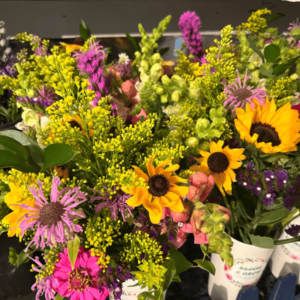
Liz: Well, I think what my customers enjoy is the fact that they can do 15 stems, and there’s maybe a couple of multiples of two or a couple multiples of three, but for the most part, there’s seven to 10 different flowers in this bouquet. It’s going to look cool, it’s gonna look interesting.
My tulip bunch bouquets in the spring are an exception – those are straight tulips. But for my summertime ones, I think that what makes them so interesting is that there are so many things to focus on. Some things are very blah on their own, as they should be … they can’t all be so much …
Abbey: Some things are just leaves.
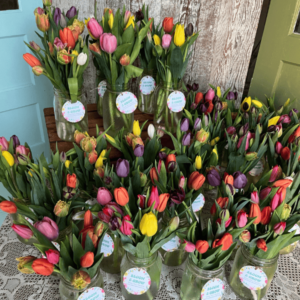
Liz: Yes, exactly. And that’s okay. I think that people are buying them because the product speaks for itself. Each individual sedan is unique, and that’s what makes them look different, and I think that’s what people like about them. They’re so different from the stuffy floral shop stuff we’re used to. I think, sometimes, some of those arrangements can look like a funeral arrangement, and that’s what they remind us of, and then we see these, and we’re like, “Oh, that looks like wildflowers. I want to go twirl in a meadow.” Even though I don’t think I’ve ever twirled in a meadow …
Abbey: Twirl in a meadow and sink Julie Andrews songs …
Liz: Exactly, or it just makes you feel like, “Someday I’m gonna go homestead with my seven children that I homeschool …”
Abbey: I’m gonna sew my own clothing.
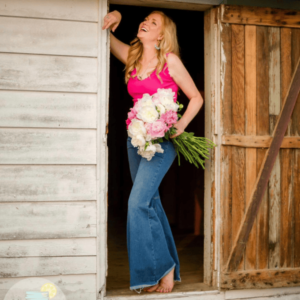
Liz: Yeah. You know, maybe I’ll just get the bouquet and call it good.
Abbey: It scratches that itch. You just grow incredible flowers, and having a helpful guide like this for how to put them together makes me want to go buy a bunch and make my own.
Liz: And if you guys have any questions, again, you can find me on Instagram at @sunnymarymeadow. Send me a question, and let me know how I can help. Honestly, my feed is full of bouquets that I’ve done … and memes of growing flowers. My customers do a really good job of tagging me in the bouquets they get from me and then take home and put in their really cute decorated houses. And I did promise myself that I’m gonna have flowers on display every week all summer long this summer. I haven’t done well at that in the past. We’ll see how that goes.
Abbey: I believe in you.
Thanks for reading the Sunny Mary Meadow blog. If you like what you’re reading, please subscribe to the podcast and rate us. You can also find us on Instagram, Pinterest, and Facebook.
You can subscribe to our email newsletter below. We love to hear any podcast-related feedback at our email podcast@sunnymarymeadow.com, and all other inquiries can be sent to liz@sunnymarymeadow.com.